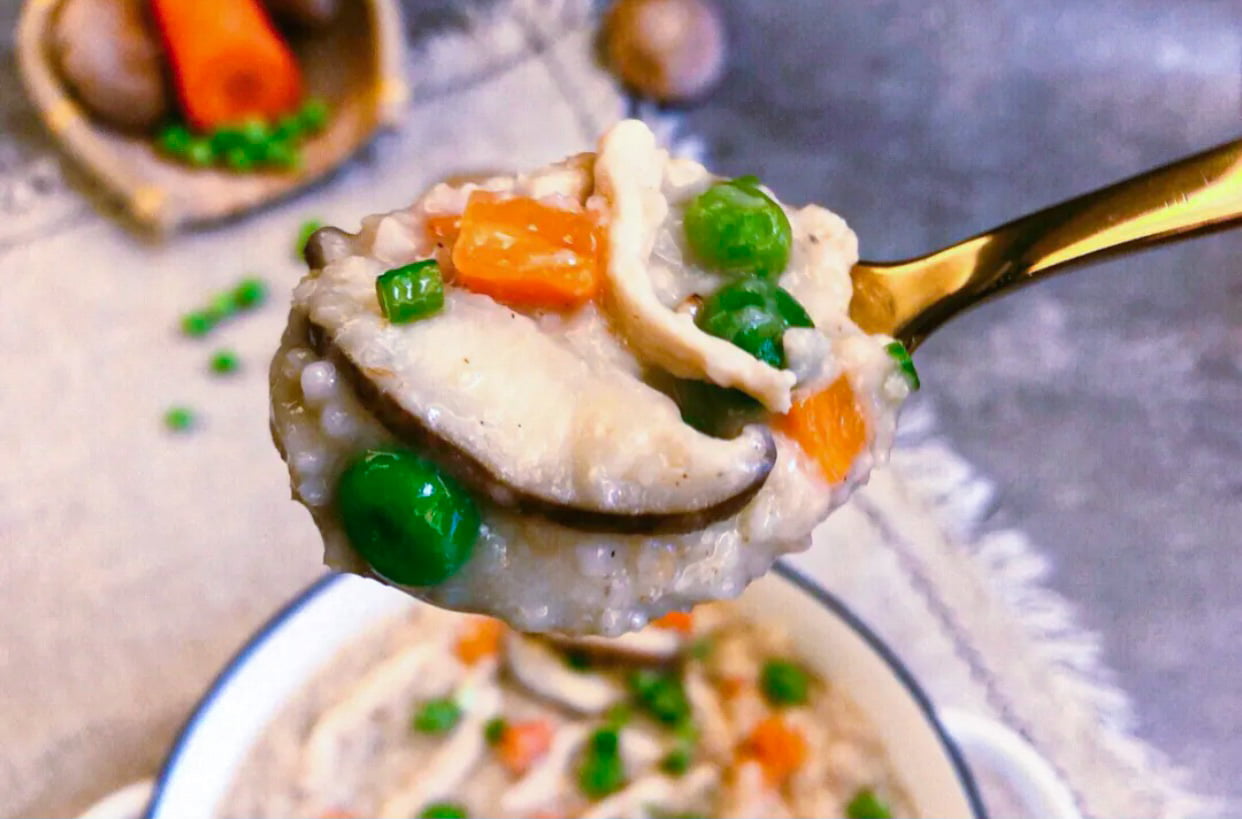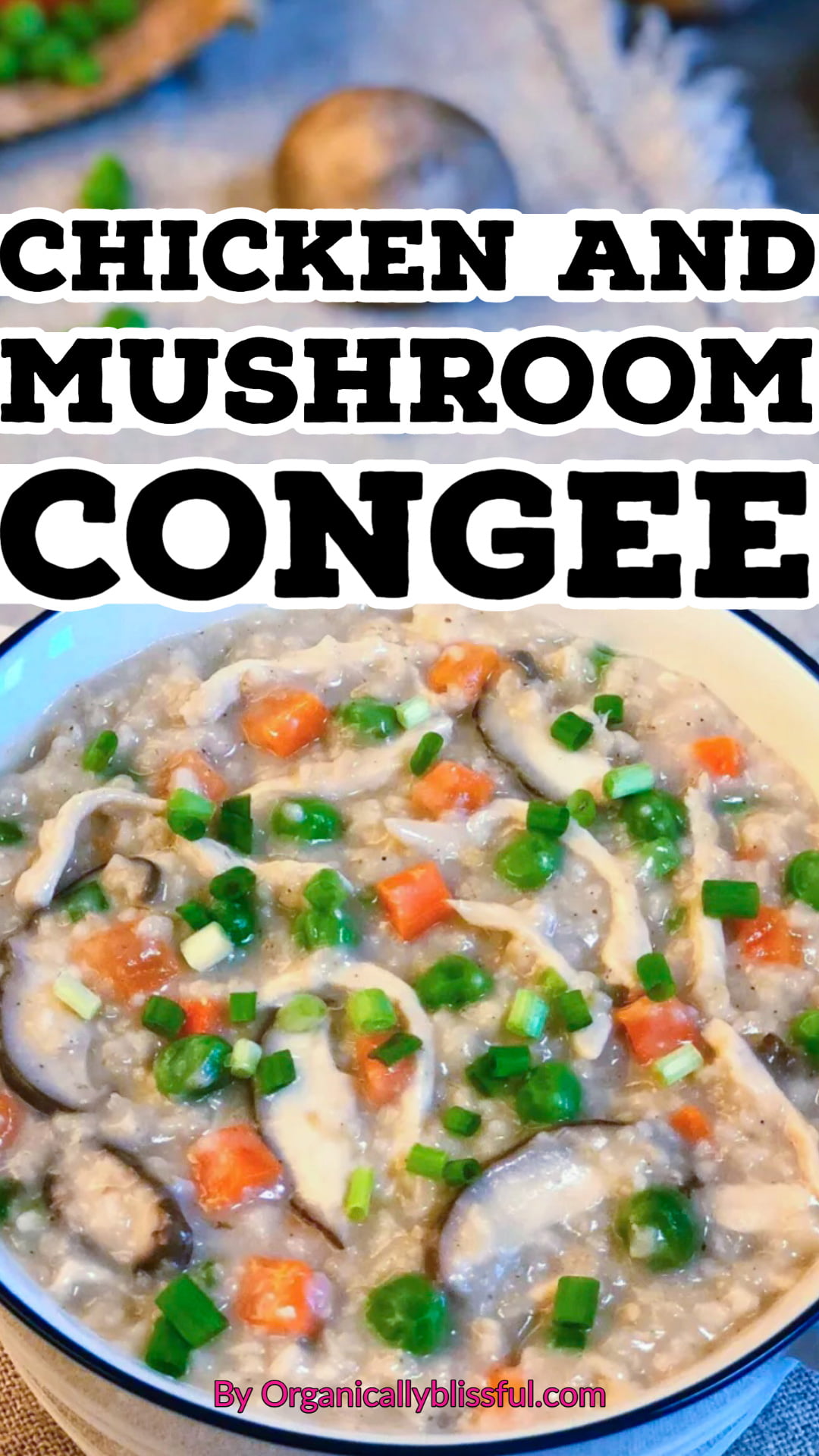At the core of chicken congee lies simplicity. The magic begins with rice simmered in a fragrant broth until it transforms into a creamy, velvety porridge. The addition of tender chicken, vegetables, aromatic herbs, and a medley of seasonings elevates this humble dish to new heights, infusing it with layers of delicate flavors that dance on your taste buds. Chicken congee is considered the epitome of Chinese comfort food.
In this blog post, we will guide you through the process of creating a chicken congee recipe and along with some cooking tips to make this ultimate Chinese comfort food.

Chicken Congee Recipe
Prep Time
10 minutes
Cook Time
75 minutes"
Rest Time
0 minutes
Total Time
1 hour and 25 minutes
Ingredients
Directions
1. To eliminate excess starch, thoroughly rinse the rice with cold water until the water runs clear.
2. Heat the avocado oil in a large pot over medium heat, then add the minced garlic, grated ginger, and the white sections of the green onions. Sauté the mixture for a few minutes until it becomes fragrant.
3. Add the chicken breast to the pot and cook until it is cooked. Remove the chicken from the pot and set it aside to cool slightly.
4. Add the mushrooms in the same pot and cook until they soften, around 2-3 minutes. Then, add the peas and carrots and cook for another 2 minutes.
5. Pour the chicken broth and water into the pot, then bring the mixture to a boil. Add the rinsed rice and reduce the heat to low. Allow the mixture to simmer, partially covered, stirring occasionally to avoid any sticking.
6. As the congee simmers, use a fork or your hands to shred the cooked chicken breast into small, bite-sized pieces.
7. After simmering for about an hour, the rice will have broken down, and the congee will have a creamy consistency. If you prefer a smoother texture, you can use the back of a spoon to mash some of the rice grains against the side of the pot.
8. Incorporate the shredded chicken into the pot and stir it into the congee. Allow it to cook for an extra 10-15 minutes to heat through thoroughly.
9. Season the congee with salt and pepper to your preferred taste.
10. Serve the chicken congee hot and garnish with the green parts of the sliced green onions. If desired, enhance the flavor by adding a delightful drizzle of toasted sesame oil and soy sauce.
Tips
Use chicken stock: Chicken stock adds an extra depth of flavor to the congee. If chicken broth is unavailable, you can substitute it with vegetable broth or water, although the flavor may be slightly milder.
Choose the right rice: Opt for long-grain or jasmine rice, as they tend to have a creamier consistency. Avoid using sticky or short-grain rice, as they can make the congee excessively thick.
Nutritional Facts
Nutrition Facts
Servings: 4
Calories
359
% Daily Value*
Total Fat 3.4g
4%
Saturated Fat 1g
5%
Cholesterol 98mg
33%
Sodium 123mg
54%
Total Carbohydrate 40.9g
15%
Dietary Fiber 3.2g
11%
Total Sugars 2.1g
Protein 42.7g
Vitamin D 63mcg
315%
Calcium 32mg
2%
Iron 3mg
19%
Potassium 148mg
3%
*The % Daily Value (DV) tells you how much a nutrient in a food serving contributes to a daily diet. 2,000 calorie a day is used for general nutrition advice.
Soak the rice: Soaking the rice before cooking when making congee is a matter of personal preference. Some people choose to soak the rice, while others do not. Soaking the rice before cooking can help soften it, which can result in a smoother texture in the final congee. If you prefer a creamier consistency, soaking the rice for 30 minutes to an hour can help achieve that.
Precooked the chicken: Cooking the chicken breasts separately before adding it to the congee helps to ensure it's fully cooked and tender. Before shredding, you can poach, grill, or sauté the chicken breast.
Sauté the aromatics: Sautéing garlic, ginger, and the white parts of green onions before adding the broth and rice helps release their flavors and adds depth to the dish.
Adjust the consistency: If the congee becomes too thick during cooking, you can add a bit of hot water or broth to thin it out to your desired consistency.
Simmer gently: To prevent the congee from sticking to the bottom of the pot, maintain a gentle simmer over low heat, remembering to stir occasionally. This slow cooking process allows the rice to break down and develop its creamy texture.
What Is Congee?
Congee or rice porridge is a cherished dish with origins in Asian cuisine and is commonly referred to as Chinese rice porridge. Congee is frequently connected with comfort, healing, and nourishment, sharing similarities with our beloved chicken noodle soup
Congee is a simple yet incredibly comforting dish made by simmering rice in a generous amount of water or broth until it reaches a smooth, creamy consistency. Rice porridge is often enjoyed as a breakfast staple or a soothing meal during times of illness or recovery, congee has gained popularity around the world for its nourishing qualities and versatility.
What Ingredients You Will Need Need To Make Chicken Congee
Rice
Rice serves as the foundation of congee, providing a creamy texture and acting as a blank canvas to absorb flavors. Long-grain rice, medium grain or jasmine rice are commonly used due to their ability to break down and release starches during cooking, resulting in a thick and velvety consistency. While you can use sushi rice to make rice porridge, it's not typically a preferred rice choice.
Chicken Stock
Chicken stock is a rich and flavorful liquid obtained by simmering chicken bones, meat, and aromatic ingredients together. It adds richness, depth, and savory notes to the congee, enhancing its overall taste profile. The broth infuses the rice with a delightful chicken essence, creating a comforting base for the dish.
If chicken stock is not available, you can opt for chicken broth. Avoid using chicken bouillon as it is high in sodium and contains artificial ingredients.
Water
Water is added along with the chicken broth to adjust the consistency of the congee. It plays a crucial role in achieving the desired consistency and balance between the rice and liquid elements. The quantity of water used can be modified according to personal preference, allowing for a thicker or thinner congee.
Chicken Breast
Boneless and skinless chicken breast is an excellent protein option for the congee. It offers a lean and tender texture. It cooks quickly and shreds easily, adding substance and flavor to the dish. The cooked chicken breast has a mild and delicate taste, complementing the other ingredients without overpowering them. For more flavor, you can use chicken thighs instead.
Mushrooms
Mushrooms, such as shiitake or button mushrooms, contribute an earthy and umami-rich flavor to the congee. Sliced mushrooms are added to the pot, providing a satisfying texture and depth of taste. They enhance the overall savory profile of the dish, harmonizing with the other ingredients.
Peas And Carrot
Diced peas and carrots bring both color and sweetness to the congee. They add vibrant pops of green and orange, making the dish visually appealing. The peas provide a burst of freshness, while the carrots contribute a slight natural sweetness. These vegetables also contribute essential vitamins, minerals, and fiber, boosting the nutritional value of the congee.
Green Onion
Green onion, or scallion, is a versatile ingredient used in both the cooking process and as a garnish. In the beginning, the white parts are sautéed with garlic and ginger, releasing their aromatic flavors and adding depth to the base of the congee. The green parts are reserved and sliced thinly to garnish the finished dish. They provide a fresh and slightly pungent taste, adding a vibrant touch and balancing the flavors.
Minced garlic is a staple in many savory dishes, including congee. It imparts a delicate yet unmistakable garlic essence, elevating the overall flavor profile of the dish. Garlic brings aromatic notes and depth, creating a robust and satisfying flavor experience.
Grated ginger is known for its unique flavor profile—warm, slightly spicy, and aromatic. It infuses the congee with a refreshing zing, providing a subtle kick and balancing the richness of the other ingredients. Ginger adds a hint of heat and depth of taste, contributing to the overall complexity of flavors.
Avocado Oil
Avocado oil serves as the medium for sautéing the garlic, ginger, and white portions of the green onions, facilitating heat transfer and preventing the ingredients from adhering to the pot. Avocado oil is a neutral option that allows the flavors of the aromatics to shine without overpowering the dish.
How To Store Leftover Congee
Allow the leftover chicken congee to cool down to room temperature before refrigerating. This helps prevent condensation and moisture buildup, which can lead to a soggy texture. Usually, chicken congee can be refrigerated for approximately 3-4 days. However, exercising discretion and evaluating the freshness and quality before consuming is advisable.
When you're ready to savor the leftover congee, you can reheat it on the stovetop or in the microwave. Add a little water or broth to adjust the consistency if needed. Stir occasionally to ensure even heating, and ensure it reaches a safe internal temperature (165°F or 74°C) before consuming.
How To Elevate Chicken Congee
Flavorful Toppings
Elevate your congee with flavorful toppings. Consider adding a drizzle of toasted sesame oil for a nutty aroma, a sprinkle of soy sauce or tamari for a savory kick, or a dash of white pepper for a hint of spiciness. Incorporating fresh herbs such as cilantro or Thai basil can infuse the dish with a vibrant burst of freshness.
Texture Contrast
Incorporate ingredients with contrasting textures to add some textural variety to your congee. For example, top your congee with crispy fried shallots or crushed roasted peanuts for a delightful crunch. You can also adorn the dish with thinly sliced scallions for added crispness.
Umami Boost
Enhance the umami flavor of your congee by adding ingredients like dried shiitake mushrooms, dried shrimp, or a splash of fish sauce. These umami-rich ingredients deepen the taste profile, making the congee more savory and satisfying.
Experiment With Flavors
You can introduce subtle variations by incorporating miso paste, Chinese five-spice powder, or even a splash of rice wine vinegar. These additions can provide unique flavor dimensions to your congee.

Frequently Asked Questions (FAQ)
Can I Make Chicken Congee In A Slow Cooker Or Instant Pot?
Chicken congee can be prepared using a slow cooker or Instant Pot. The cooking time will fluctuate based on the particular appliance and settings. Follow the manufacturer's instructions or find a recipe specifically for slow cooker or Instant Pot cooking. Note that Instant Pot chicken congee will have a slightly different texture than the stovetop version due to the cooking pressure.
Can I Freeze Chicken Congee For Later Use?
Yes, chicken congee can be frozen for future consumption. Ensure the congee cools down entirely, then transfer it to airtight containers or freezer bags. Don't forget to label the containers with the date and store them in the freezer for up to 3 months. Thaw in the refrigerator overnight before reheating.
How Can I Make My Chicken Congee Thicker Or Thinner In Consistency?
To make the chicken congee thicker, continue cooking it uncovered over low heat to allow more liquid to evaporate and the rice to break down further. Should you desire a thinner consistency, feel free to incorporate additional liquid, such as chicken broth or water, and adjust the seasoning accordingly.
Can I Make Chicken Congee Without Using Any Meat?
Yes, you can make chicken congee without meat for vegetarian or vegan versions. Simply omit the chicken and focus on adding vegetables, mushrooms, or tofu for flavor and protein.

